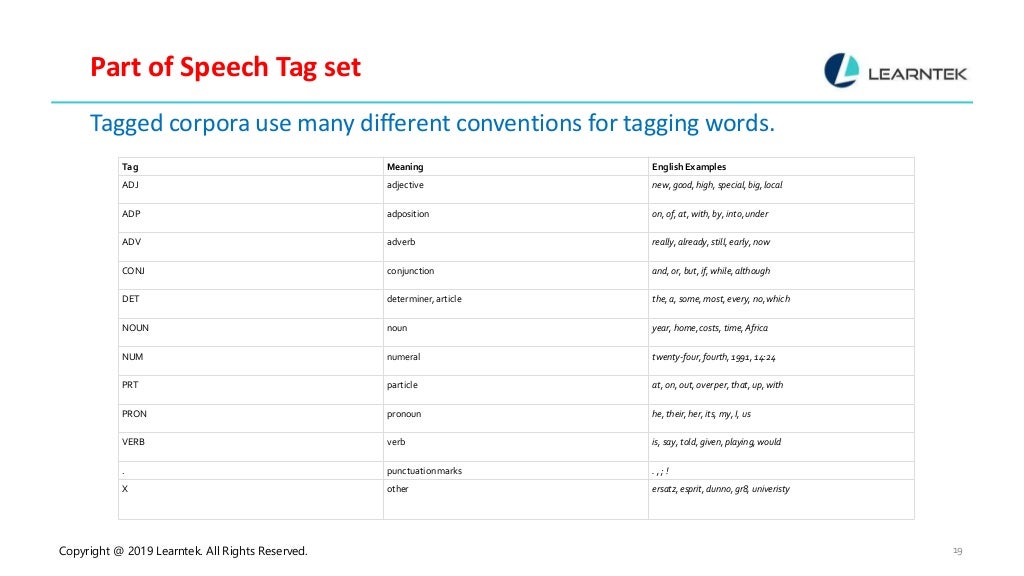


Rule-based taggers use a dictionary (i.e. This usually happens under the hood when the nlp object is called on a textĪnd all pipeline components are applied to the Doc in order. What are rule-based POS tagger One of the oldest techniques of tagging is rule-based POS tagging. The document is modified in place, and returned. Defaults to Scorer.score_token_attr for the attribute "tag".
POS TAGGER PYTHON CODE
Actually this code returns when it should returns. The function returns a list of matched strings. Whether existing annotation is overwritten. The match function takes in a tagged text (a list of tuples where the first element of each tuple is a word and the second element is its part-of-speech tag), a regular expression pattern, a match string, and a list of part-of-speech tags. Used to add entries to the losses during training. The output vectors should match the number of tags in size, and be normalized as probabilities (all scores between 0 and 1, with the rows summing to 1). Firstly, doesn't execute and no specific instructions are provided about what to import. Shortcut for this and instantiate the component using its string name andĪ model instance that predicts the tag probabilities.

In your application, you would normally use a CHANGES 0.3.3 ()īundle model files (model_ja.json, model_ja_min.Create a new pipeline instance. Rma.tag_scheme = “SBIEO” # if using Chinese, set “IOB2” Rma.featset = CTYPE_JA_PATTERNS # fault_featset_ja tokenize ( "うらにわにはにわにわとりがいる" )) NOTE Added APIĪs compared to original RakutenMA, following methods are added:Īs initial setting, following values are set: train_one (, ,, ,, , ]) # The result of train_one contains: # sys: the system output (using the current model) # ans: answer fed by the user # update: whether the model was updated print ( res ) # Now what does the result look like? print ( rma. tokenize ( "うらにわにはにわにわとりがいる" )) # Re-train the model feeding the right answer (pairs of ) res = rma. create_hash_func ( 15 ) # Tokenize one sample sentence print ( rma. To see the detail of each named entity, you can use the text, label, and the spacy.explain method which takes the entity object as a parameter. load ( "model_ja.json" ) # Set the feature hash function (15bit) rma. tokenize ( "彼は新しい仕事できっと成功するだろう。" )) # Initialize a RakutenMA instance with a pre-trained model rma = RakutenMA ( phi = 1024, c = 0.007812 ) # Specify hyperparameter for SCW (for demonstration purpose) rma. train_one ( i ) # Now what does the result look like? print ( rma. load ( open ( "tatoeba.json" )) for i in tatoeba : rma. tokenize ( "彼は新しい仕事できっと成功するだろう。" )) # Feed the model with ten sample sentences from # "tatoeba.json" is available at import json tatoeba = json. Hidden Markov Models (HMM) is a simple concept which can explain most complicated real time processes such as speech recognition and speech generation, machine translation, gene recognition for bioinformatics, and human gesture.
POS TAGGER PYTHON INSTALL
Rakuten MA Python (morphological analyzer) is a Python version of Rakuten MA (word segmentor + PoS Tagger) for Chinese and Japanese.Ĭontributions are welcome! Installation pip install rakutenma Example from rakutenma import RakutenMA # Initialize a RakutenMA instance with an empty model # the default ja feature set is set already rma = RakutenMA () # Let's analyze a sample sentence (from ) # With a disastrous result, since the model is empty! print ( rma. Part of Speech Tagging (POS) is a process of tagging sentences with part of speech such as nouns, verbs, adjectives and adverbs, etc.


 0 kommentar(er)
0 kommentar(er)
